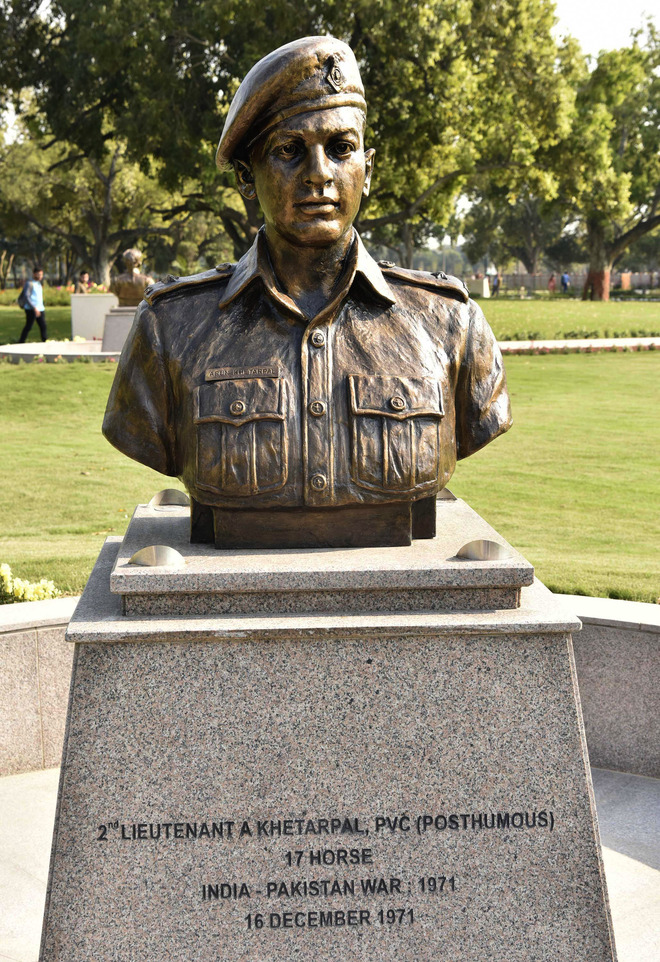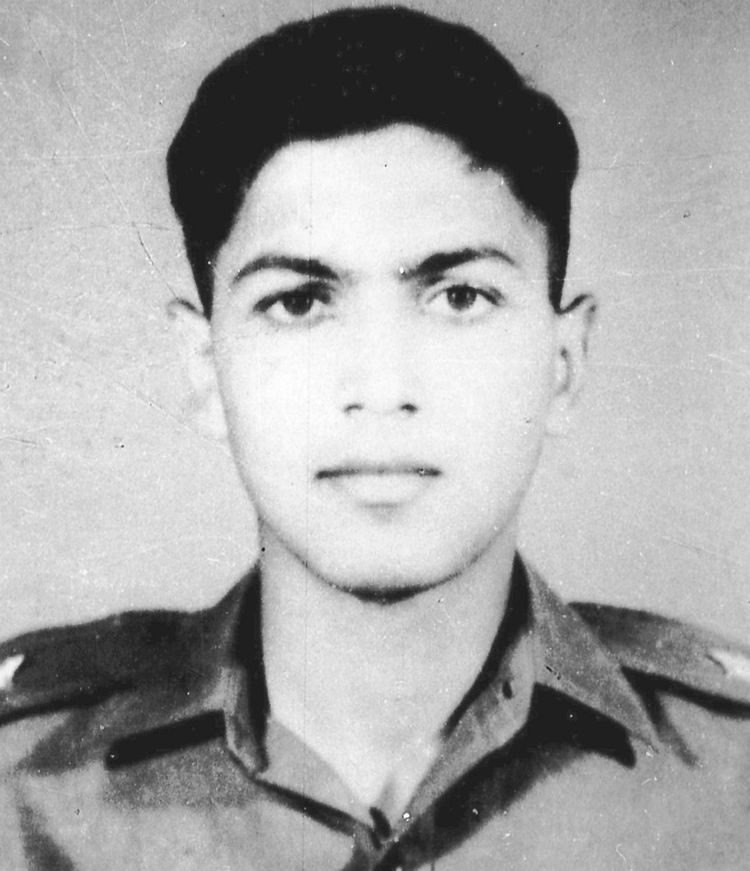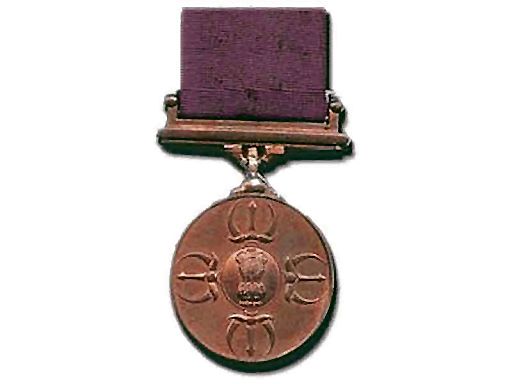
Second Lieutenant Arun Khetarpal’s bust at Param Yodha Sthal, National War Memorial, New Delhi. Tribune photo: Mukesh Aggarwal
Lt Col Dilbag Singh Dabas
Some spoken words become immortal, like: “No Sir, I will not abandon my tank. My gun is still working and the b…… are within range” — Second Lieutenant Arun Khetarpal’s radio message to his Squadron Second-in-Command when told to abandon his tank after it was hit by the enemy tank. Or: “Your grandfather was a brave soldier, so is your father. Go fight like a lion till the end” — Mrs Maheshwari Khetarpal to her 21-year-old son Arun, while seeing him off for the war at the New Delhi railway station.
Arun Khetarpal was a fourth generation soldier and wars were not new to the Khetarpals; his great-grandfather fought the British as part of the Sikh army, his grandfather fought the Turks in World War I and his father, Brigadier ML Khetarpal, was a decorated Sapper.

Arun was born on October 14, 1950, and spent five years at Lawrence School, Sanawar, wherefrom he was selected for the National Defence Academy. He carried forward his remarkable performance to the Indian Military Academy and was commissioned into The Poona Horse on June 13, 1971.
The Poona Horse was raised in 1817 near Corygaum (present-day Koregaon between Pune and Ahmednagar). Under the British East India Company, after the very first successful battle it fought on January 1, 1818, at Corygaum on the banks of Bhima river against the numerically superior forces of the Peshwa, it earned the Battle Honour “Corygaum”.

With a formidable combination of a squadron each of Jats, Sikhs and Rajputs, The Poona Horse was, and is, the highest decorated cavalry regiment in the Indian Army and also possibly in the Commonwealth. Second Lieutenant Arun Khetarpal was all too aware of the glorious past of his regiment — five Victoria Crosses and one Param Vir Chakra — and aspired to carry forward this legacy.
During the third round with Pakistan in December 1971, some fierce tank battles raged in the western theatre at Barapind and Jarpal in the Basantar Nadi area of Pakistan’s Zafarwal-Shakargarh sector. Many classic encounters took place between tanks of the Indian Army’s 16 Independent Armoured Brigade, comprising The Poona Horse and Hodson’s Horse (16 Cavalry, the third regiment, deployed in a defensive posture), and forward two regiments of the Pakistan Army’s 8 Independent Armoured Brigade, comprising 13 Lancers and 31 Cavalry, whilst its third regiment, 27 Cavalry, remained in reserve.
During the Indian Battle of the Bulge-like scenario around Jarpal, in the initial encounter in the early hours of December 16, a couple of tanks were hit. The battle, however, raged on through the morning with unequal tank casualties on both sides. Finally, by 9 am, three tanks (that of Capt V Malhotra [Mallu], Lieutenant Avtar Ahlawat and 2/Lt Arun Khetarpal) participated in the epic tank versus tank battle at Jarpal. At this most crucial stage, Avtar’s tank was hit and he had to pull back to douse the fire, and Mallu’s tank developed a snag in its main gun. Thus, for around half an hour, it was Arun alone who stood like a rock of Gibraltar between defeat and victory.
Mallu and Avtar rejoined the battle as soon as their tanks were functional; however, in that unequal battle of around 30 minutes, Arun knocked off four Patton tanks. Just then, his tank was hit and caught fire but he refused to abandon his now-damaged tank named ‘Famagusta’, since its gun was still firing. Not willing to concede even an inch to the onrushing Pakistani forces, this young subaltern, the lone fighter, was finally killed when his tank received another direct hit, this time from a tank commanded by Major Khwaja Naser, the opposing Squadron Commander of 13 Lancers. But by then, Arun had done more than enough to carve not just his own name, but also the name of The Poona Horse into the pages of Indian military history.
For his dauntless courage, dogged determination and supreme sacrifice in the face of the enemy, Second Lieutenant Arun Khetarpal was posthumously awarded the Param Vir Chakra. The battle account reads:
“On December 16, 1971, the Squadron Commander of ‘B’ Squadron, The Poona Horse, asked for reinforcements as the Pakistani armour, which was superior in strength, counter-attacked Jarpal in the Shakargarh sector. On hearing this transmission on the regimental net, Second Lieutenant Arun Khetarpal, who was in ‘A’ Squadron, voluntarily moved along with his troop to assist the other Squadron. En route, while crossing the Basantar river, Second Lieutenant Arun Kheterpal and his troop came under fire from enemy strong points and RCL gun nests that were still holding out. Time was at a premium and as a critical situation was developing in ’B’ Squadron sector, Second Lieutenant Arun Kheterpal threw caution to the winds and started attacking the impending enemy strong points by literally charging them, overrunning the defence works with his tanks and capturing the enemy infantry and weapon crews at pistol-point. In the course of one such daring attack, one tank commander of his troop was killed. Khetarpal continued to attack relentlessly until all enemy opposition was overcome and he broke through towards ‘B’ Squadron position, just in time to see the enemy tanks pulling back after their initial probing attack.
He was so carried away by wild enthusiasm of battle and the impetus of his own headlong dash that he started chasing the withdrawing tanks and even managed to shoot and destroy one. Soon thereafter, the enemy re-formed with a squadron of armour for a second attack and this time, they selected the sector held by Second Lieutenant Arun Khetarpal and two other tanks as the point for their main effort. A fierce tank fight ensued; 10 enemy tanks were hit and destroyed, of which Second Lieutenant Arun Khetarpal personally destroyed four but in that fierce engagement, he himself was severely wounded. He was told to abandon his tank but he realised that the enemy, though badly decimated, was continuing to advance and if he abandoned his tank, the enemy would break through; he gallantly fought on and destroyed another enemy tank. At this stage, his tank received a second hit which resulted in the death of this gallant officer.
Second Lieutenant Arun Khetarpal was dead but he had, by his intrepid valour, saved the day; the enemy was denied the breakthrough which it was so desperately seeking. Not one enemy tank got through.
Second Lieutenant Arun Khetarpal had shown the best qualities of leadership, tenacity of purpose and the will to close in. His was an act of dauntless courage and self-sacrifice far beyond the call of duty”.
He was not the only hero to emerge from the Battle of Basantar. Major Hoshiar Singh, commanding ‘C’ company of 3 Grenadiers, just a few hundred yards away, lived to tell his tale and the courage and bravery of his company, as the only surviving PVC awardee from the 1971 war.
More than 30 years later, a poignant meeting between Arun Khetarpal’s father and by now Brigadier Khwaja Naser of Pakistan army, who is believed to have fired the fatal shot on Arun’s tank, reveals that despite the prolonged enmity between the two countries, deep professional respect for each other exists within their militaries.
Brigadier Brijendra Singh (then Second Lieutenant and the writer’s course-mate at OTS, Madras) and Second Lieutenant Arun Khetarpal, both from The Poona Horse, had reported to Ahmednagar on October 11, 1971, for the Young Officer’s Course, a necessary initiation for all officers prior to taking command of their tanks and men. Due to war clouds hovering rather low, the course was terminated after just three days. They celebrated Arun’s 21st birthday on October 14 in a hurry, and boarded the Punjab Mail on their journey back to the regiment, with an interlude at New Delhi, where Arun received his mother’s blessings.
Having noticed Arun carrying his ceremonial Blue Patrol clothing and golf clubs along, Brij asked why he needed these on way to fighting a war. And the reply by the 21-year-old was classic: ‘Sir, I plan to play golf in Lahore. And I am sure there will be a dinner night after we win the war, so I’ll need the Blue Patrol dress as well.’
Some people are like that.
— The writer is Gunner Veteran
Join Whatsapp Channel of The Tribune for latest updates.




















